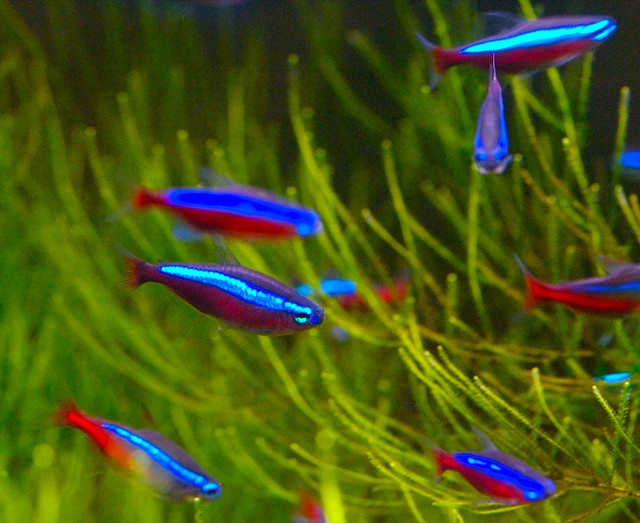| Neon Tetra Photo: Wikipedia |
Neon tetras are inexpensive and sturdy fish ideal for beginners. As they have a good temperament, they fit well in a community aquarium. They can grow only up to 1 inch and they do not have any eating habits.
Cardinal tetras will grow up to 2 inches and they are expensive because their breeding in captivity is very difficult. They need to be imported from the South American region.
As neon tetras are hardy fish, they can tolerate variations in the living conditions. If there is any major change in the temperature of the water or the ph level, they will try to cope up with that environment. Out of the whole family of tetra fish, neon tetras are the toughest. On the other hand, cardinal tetras are very sensitive to the conditions of water and a slight change in the conditions of water may affect them in a big way.
| Cardinal Tetra Photo: Wikipedia |
Both cardinal tetras and neon tetras are schooling fish and the need to live in a group. When you decide to keep any of them, you should buy a group of at least 10. If they are kept alone, they will get stressed and will get sick and may die.
Both these species can eat any type of food offered to them. They love to eat live food but at the same time, they can eat boiled vegetables and flaked food. Both of them can eat small insects and worm which are present in the water.
However, both of these species love to remain in the middle level of the aquarium. So when you decide to keep both of them in one tank, there will be problems. Even though your aquarium is large, if both of them want to occupy the middle area, there will be territorial problems. In addition, there will be problems during the breeding periods of neon tetras. Their eggs may be eaten by cardinal tetras. So it is better to keep only one of them in the aquarium.
It is a difficult decision to make. However, here are a few guidelines for you:
1. If your budget is limited, cardinal tetras will be expensive for you. So you should go for neon tetras.2. If you are a beginner, it will be very difficult for you to keep ideal conditions of water in the aquarium all the time. Even a slight variation in the conditions may hurt cardinal tetras. So you may select neon tetras to start with. Later you can think of keeping cardinal tetras.3. However, if you have some experience in fish-keeping, and you want to show off your aquarium to your family and visitors, you can select cardinal tetras. Their beautiful bright red color will shine against appropriate background of substrate and decorations.
It is difficult to breed neon tetra is in captivity but it is almost impossible for the experienced breeders to try for cardinal tetras. Considering their huge demand, some experienced breeders may try to sell you something which they will label as neon tetras or cardinal tetras. The fish will be cheaper but may not show their bright colors and they may look dull and inactive. Most of the times, they may die soon after bringing home. So you should be careful while purchasing any of them. You should speak in details to the staff of the pet fish store and if possible consult your friends before you buy.
Chintamani Abhyankar is a goldfish enthusiast and has been raising and breeding goldfish for many years. He is an expert on their care and an advocate for raising healthy goldfish the natural way.
Article Source: EzineArticles
|




